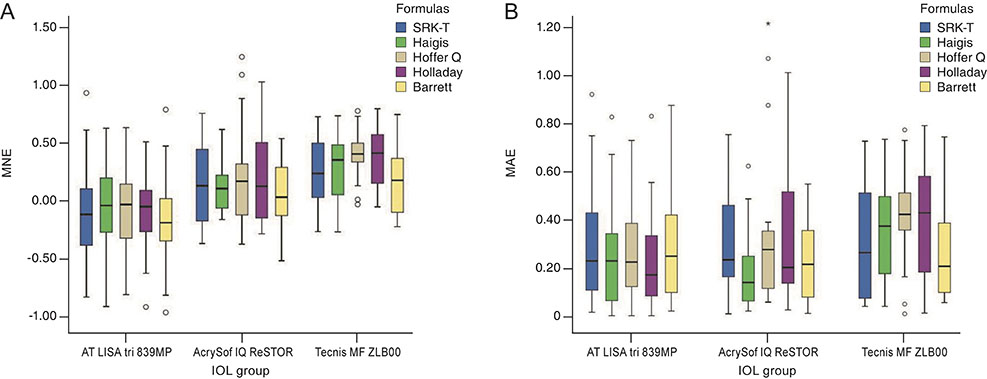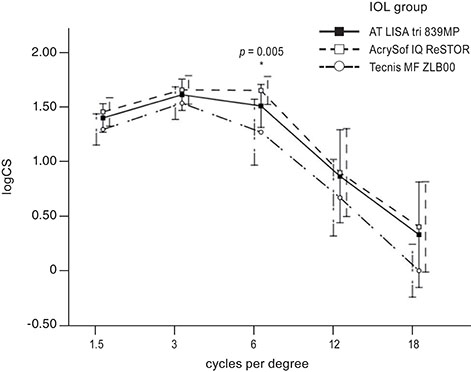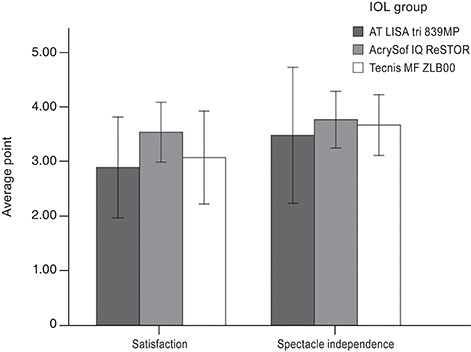Korean J Ophthalmol.
2019 Aug;33(4):333-342. 10.3341/kjo.2019.0001.
Effects of Bifocal versus Trifocal Diffractive Intraocular Lens Implantation on Visual Quality after Cataract Surgery
- Affiliations
-
- 1Department of Ophthalmology, Seoul National University College of Medicine, Seoul, Korea. kmk9@snu.ac.kr
- 2Department of Ophthalmology, Seoul National University Bundang Hospital, Seoul National University College of Medicine, Seongnam, Korea.
- 3Laboratory of Ocular Regenerative Medicine and Immunology, Seoul Artificial Eye Center, Seoul National University Hospital Biomedical Research Institute, Seoul, Korea.
- KMID: 2454774
- DOI: http://doi.org/10.3341/kjo.2019.0001
Abstract
- PURPOSE
To compare the effects of bifocal versus trifocal diffractive intraocular lens (IOL) implantation on visual quality after phacoemulsification in patients with cataracts.
METHODS
Eighty-eight eyes from 63 patients were analyzed. Trifocal (AT LISA tri 839MP), bifocal (AcrySof IQ ReSTOR) and bifocal (Tecnis MF ZLB00) IOLs were implanted into 53, 18, and 17 eyes, respectively. Uncorrected distance, intermediate and near visual acuity, refractive errors, contrast sensitivity, and patient satisfaction were measured at 1 week and 1 month after surgery. Refractive error was converted to a spherical equivalent and compared to predicted refraction calculated by IOL calculation formulas.
RESULTS
Uncorrected distance, intermediate, and near visual acuity did not differ significantly between groups. One month after surgery, the mean refractive errors were −0.07 diopters (D) in the AT LISA tri 839MP group, +0.18 D in the AcrySof IQ ReSTOR group, and +0.31 D in the Tecnis MF ZLB00 group (p < 0.001). The predictive accuracy of IOL calculation formulas did not differ between groups. Contrast sensitivity, satisfaction, and spectacle independence in the trifocal group were comparable with those of the two bifocal groups.
CONCLUSIONS
Trifocal IOL and two different types of bifocal IOL implantation were all effective for improving visual quality, although refractive error in patients with trifocal IOL shows myopic tendencies.
MeSH Terms
Figure
Reference
-
1. Martinez Palmer A, Gomez Faina P, Espana Albelda A, et al. Visual function with bilateral implantation of monofocal and multifocal intraocular lenses: a prospective, randomized, controlled clinical trial. J Refract Surg. 2008; 24:257–264.
Article2. Agresta B, Knorz MC, Kohnen T, et al. Distance and near visual acuity improvement after implantation of multifocal intraocular lenses in cataract patients with presbyopia: a systematic review. J Refract Surg. 2012; 28:426–435.
Article3. Leyland M, Zinicola E. Multifocal versus monofocal intraocular lenses in cataract surgery: a systematic review. Ophthalmology. 2003; 110:1789–1798.4. Souza CE, Muccioli C, Soriano ES, et al. Visual performance of AcrySof ReSTOR apodized diffractive IOL: a prospective comparative trial. Am J Ophthalmol. 2006; 141:827–832.
Article5. Alio JL, Elkady B, Ortiz D, Bernabeu G. Clinical outcomes and intraocular optical quality of a diffractive multifocal intraocular lens with asymmetrical light distribution. J Cataract Refract Surg. 2008; 34:942–948.6. Kohnen T, Allen D, Boureau C, et al. European multicenter study of the AcrySof ReSTOR apodized diffractive intraocular lens. Ophthalmology. 2006; 113:584.e1.
Article7. Alio JL, Tavolato M, De la Hoz F, et al. Near vision restoration with refractive lens exchange and pseudoaccommodating and multifocal refractive and diffractive intraocular lenses: comparative clinical study. J Cataract Refract Surg. 2004; 30:2494–2503.8. Yoshino M, Bissen-Miyajima H, Minami K, Taira Y. Five-year postoperative outcomes of apodized diffractive multifocal intraocular lens implantation. Jpn J Ophthalmol. 2013; 57:510–513.
Article9. Woodward MA, Randleman JB, Stulting RD. Dissatisfaction after multifocal intraocular lens implantation. J Cataract Refract Surg. 2009; 35:992–997.
Article10. Montes-Mico R, Alio JL. Distance and near contrast sensitivity function after multifocal intraocular lens implantation. J Cataract Refract Surg. 2003; 29:703–711.11. Pieh S, Lackner B, Hanselmayer G, et al. Halo size under distance and near conditions in refractive multifocal intraocular lenses. Br J Ophthalmol. 2001; 85:816–821.
Article12. Bilbao-Calabuig R, Gonzalez-Lopez F, Amparo F, et al. Comparison between mix-and-match implantation of bifocal intraocular lenses and bilateral implantation of trifocal intraocular lenses. J Refract Surg. 2016; 32:659–663.
Article13. Gundersen KG, Potvin R. Comparison of visual outcomes after implantation of diffractive trifocal toric intraocular lens and a diffractive apodized bifocal toric intraocular lens. Clin Ophthalmol. 2016; 10:455–461.14. Cochener B. Prospective clinical comparison of patient outcomes following implantation of trifocal or bifocal intraocular lenses. J Refract Surg. 2016; 32:146–151.
Article15. Mojzis P, Kukuckova L, Majerova K, et al. Comparative analysis of the visual performance after cataract surgery with implantation of a bifocal or trifocal diffractive IOL. J Refract Surg. 2014; 30:666–672.
Article16. Jonker SM, Bauer NJ, Makhotkina NY, et al. Comparison of a trifocal intraocular lens with a +3.0 D bifocal IOL: results of a prospective randomized clinical trial. J Cataract Refract Surg. 2015; 41:1631–1640.
Article17. Voskresenskaya A, Pozdeyeva N, Pashtaev N, et al. Initial results of trifocal diffractive IOL implantation. Graefes Arch Clin Exp Ophthalmol. 2010; 248:1299–1306.
Article18. Madrid-Costa D, Ruiz-Alcocer J, Ferrer-Blasco T, et al. Optical quality differences between three multifocal intraocular lenses: bifocal low add, bifocal moderate add, and trifocal. J Refract Surg. 2013; 29:749–754.
Article19. Montes-Mico R, Madrid-Costa D, Ruiz-Alcocer J, et al. In vitro optical quality differences between multifocal apodized diffractive intraocular lenses. J Cataract Refract Surg. 2013; 39:928–936.20. Sheppard AL, Shah S, Bhatt U, et al. Visual outcomes and subjective experience after bilateral implantation of a new diffractive trifocal intraocular lens. J Cataract Refract Surg. 2013; 39:343–349.
Article21. Law EM, Aggarwal RK, Kasaby H. Clinical outcomes with a new trifocal intraocular lens. Eur J Ophthalmol. 2014; 24:501–508.
Article22. Mojzis P, Pena-Garcia P, Liehneova I, et al. Outcomes of a new diffractive trifocal intraocular lens. J Cataract Refract Surg. 2014; 40:60–69.
Article23. Cochener B, Vryghem J, Rozot P, et al. Visual and refractive outcomes after implantation of a fully diffractive trifocal lens. Clin Ophthalmol. 2012; 6:1421–1427.
Article24. Kohnen T, Titke C, Bohm M. Trifocal intraocular lens implantation to treat visual demands in various distances following lens removal. Am J Ophthalmol. 2016; 161:71–77.25. Schwarz C, Canovas C, Manzanera S, et al. Binocular visual acuity for the correction of spherical aberration in polychromatic and monochromatic light. J Vis. 2014; 14:DOI: 10.1167/14.2.8.
Article26. Vega F, Alba-Bueno F, Millan MS. Energy distribution between distance and near images in apodized diffractive multifocal intraocular lenses. Invest Ophthalmol Vis Sci. 2011; 52:5695–5701.
Article27. Gatinel D, Houbrechts Y. Comparison of bifocal and trifocal diffractive and refractive intraocular lenses using an optical bench. J Cataract Refract Surg. 2013; 39:1093–1099.
Article28. Vinas M, Gonzalez-Ramos A, Dorronsoro C, et al. In vivo measurement of longitudinal chromatic aberration in patients implanted with trifocal diffractive intraocular lenses. J Refract Surg. 2017; 33:736–742.
Article29. Gundersen KG, Potvin R. Comparison of visual outcomes and subjective visual quality after bilateral implantation of a diffractive trifocal intraocular lens and blended implantation of apodized diffractive bifocal intraocular lenses. Clin Ophthalmol. 2016; 10:805–811.30. Carson D, Hill WE, Hong X, Karakelle M. Optical bench performance of AcrySof((R)) IQ ReSTOR((R)), AT LISA((R)) tri, and FineVision((R)) intraocular lenses. Clin Ophthalmol. 2014; 8:2105–2113.31. Plaza-Puche AB, Alio JL, Sala E, Mojzis P. Impact of low mesopic contrast sensitivity outcomes in different types of modern multifocal intraocular lenses. Eur J Ophthalmol. 2016; 26:612–617.
Article32. Green DG, Campbell FW. Effect of focus on the visual response to a sinusoidally modulated spatial stimulus. J Opt Soc Am. 1965; 55:1154–1157.
Article33. Tan N, Zheng D, Ye J. Comparison of visual performance after implantation of 3 types of intraocular lenses: accommodative, multifocal, and monofocal. Eur J Ophthalmol. 2014; 24:693–698.
Article34. Kim JS, Jung JW, Lee JM, et al. Clinical outcomes following implantation of diffractive multifocal intraocular lenses with varying add powers. Am J Ophthalmol. 2015; 160:702–709.
Article35. Yang CM, Lim DH, Hwang S, et al. Prospective study of bilateral mix-and-match implantation of diffractive multifocal intraocular lenses in Koreans. BMC Ophthalmol. 2018; 18:73.
Article
- Full Text Links
- Actions
-
Cited
- CITED
-
- Close
- Share
- Similar articles
-
- Comparison of the Visual Outcomes after Cataract Surgery with Implantation of a Bifocal and Trifocal Diffractive Intraocular Lens
- Trifocal versus Bifocal Diffractive Intraocular Lens Implantation after Cataract Surgery or Refractive Lens Exchange: a Meta-analysis
- Comparison of Reading Speed after Bilateral Bifocal and Trifocal Intraocular Lens Implantation
- Clinical Outcomes of Diffractive Aspheric Trifocal Intraocular Lens Implantation
- Clinical Outcomes of Patients Fitted with Bifocal and Trifocal Diffractive Intraocular Lenses






